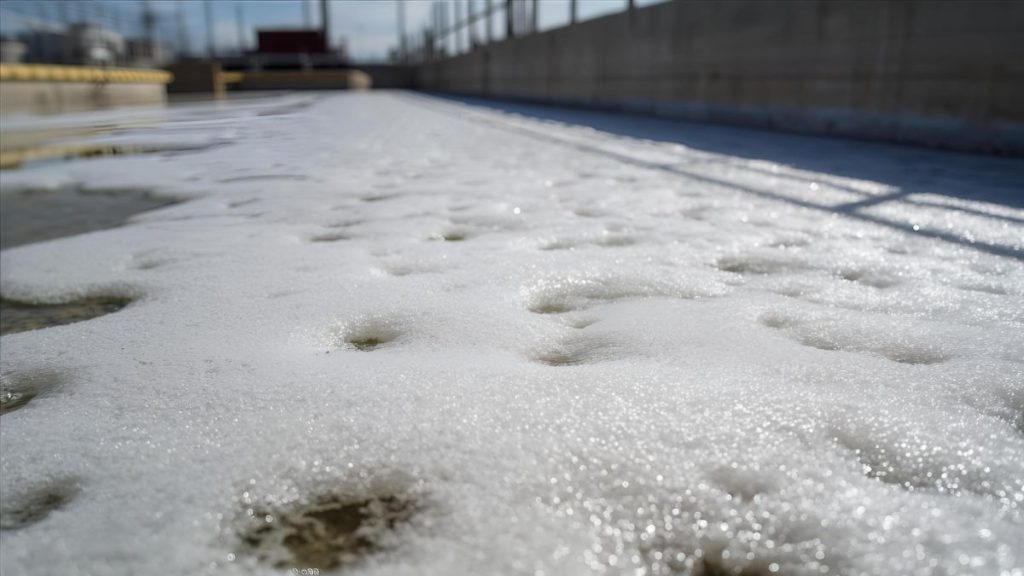Foam might seem like a harmless byproduct of industrial and wastewater processes, but in reality, it can create significant operational challenges. The role of antifoam in wastewater treatment is essential to maintaining process stability, preventing equipment damage, and ensuring compliance with environmental regulations.
By understanding how foam forms, why it becomes problematic, and how antifoams are applied, industries can operate more efficiently and sustainably.
What is Foam?
Foam is a mass of small gas bubbles trapped in a liquid or semi-liquid phase, stabilized by surface-active agents (surfactants). These bubbles cluster together, forming a stable structure that resists collapse.
Foam formation in wastewater treatment systems is primarily caused by:
- Surfactants and detergents: Present in industrial effluents, cleaning agents, and domestic wastewater.
- Biological activity: Excess microbial growth, especially filamentous bacteria, can stabilize foam.
- Agitation and aeration: Mechanical mixing, aerators, or blowers used in treatment plants promote foam generation.
While foam may appear on the surface, its presence often indicates deeper operational issues that need to be addressed.
Read Also: Foaming in Wastewater: Common Problems and Control Strategies
Why Foam is a Problem in Wastewater Treatment?
Foam in wastewater treatment plants (WWTPs) is not just an aesthetic issue. It can disrupt processes, damage equipment, and compromise effluent quality. The major problems caused by foam include:
1. Reduced Efficiency of Aeration Systems
In activated sludge processes, aeration is critical for supplying oxygen to microorganisms. Foam accumulation reduces oxygen transfer efficiency, hindering biological treatment.
2. Sludge Bulking and Loss of Solids
Foam often carries biomass and solids, which can overflow into clarifiers or effluent streams. This increases sludge bulking, reduces settling performance, and leads to poor effluent quality.
3. Operational and Maintenance Challenges
Excess foam can block sensors, coat equipment, and interfere with pumps or mixers. Over time, this leads to higher maintenance costs and unplanned downtime.
4. Environmental and Safety Risks
Foam can overflow treatment tanks, creating odor problems and safety hazards for plant operators. In severe cases, uncontrolled foam can even cause regulatory compliance issues.
5. Energy and Cost Implications
When foam reduces aeration efficiency or causes operational inefficiencies, plants often compensate by using more energy, chemicals, or labor. This raises operational costs significantly.
Given these challenges, effective foam control becomes a vital part of wastewater management strategies.
Difference Between Antifoam and Defoamer
Although often used interchangeably, antifoam and defoamer have slightly different functions in foam management. Understanding this distinction helps industries choose the right product for their needs.
Antifoam
- Purpose: Prevents foam formation before it becomes a visible or operational issue.
- Mechanism: Works by destabilizing the surfactant layer at the air-liquid interface, making it difficult for bubbles to form.
- Application: Used proactively in processes where foam generation is expected, such as aeration tanks, clarifiers, and biological treatment units.
Defoamer
- Purpose: Eliminates existing foam that has already formed.
- Mechanism: Spreads across the foam surface, weakening bubble walls, and causing them to collapse.
- Application: Typically added when foam suddenly appears and requires immediate control.
Key Distinction
- Antifoam = Preventive measure
- Defoamer = Corrective measure
In wastewater treatment, both are important. Antifoams maintain stability over time, while defoamers serve as an emergency solution when unexpected foaming occurs.
Read Also: Foaming in Cooling Towers: A Problem that Disrupts Efficiency
The Role of Antifoam in Wastewater Treatment
The role of antifoam in wastewater treatment is multifaceted, addressing both operational and compliance-related challenges. By adding antifoam agents strategically, treatment plants can ensure smooth, efficient, and reliable performance.
1. Improving Process Efficiency
Antifoams prevent foam from forming in aeration tanks and biological reactors. This ensures uninterrupted oxygen transfer, allowing microorganisms to effectively break down organic matter.
2. Protecting Equipment and Sensors
Excess foam can coat sensors and damage equipment such as pumps, blowers, and mixers. By preventing foam buildup, antifoams safeguard sensitive instruments and extend equipment life.
3. Enhancing Effluent Quality
Foam often carries suspended solids and biomass that compromise effluent clarity. Antifoams prevent this, ensuring that treated water meets regulatory discharge standards.
4. Reducing Maintenance Costs
Without foam, plants face fewer blockages, overflows, and mechanical failures. This translates to reduced maintenance downtime and lower repair costs.
5. Supporting Environmental Compliance
Foam overflow can cause odor problems and environmental pollution. Antifoams minimize these risks, helping industries maintain compliance with environmental regulations.
Conclusion
Foam in wastewater treatment may appear simple, but its impact can be severe, ranging from reduced efficiency to environmental non-compliance. The role of antifoam is therefore critical in preventing foam-related challenges, ensuring operational stability, and protecting both equipment and the environment.
By choosing the right antifoam products and implementing them strategically, treatment plants can avoid costly disruptions and maintain smooth performance. Partnering with an experienced provider like Lautan Air Indonesia ensures not only access to quality chemicals but also technical expertise, service support, and a commitment to long-term success.
If your wastewater system is facing foam-related challenges, Lautan Air Indonesia can provide the right solution, delivering both products and services to keep your operations running at their best.
Contact us today to discuss your wastewater treatment challenges and discover how our antifoam solutions can keep your system running at its best.



